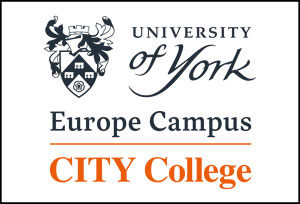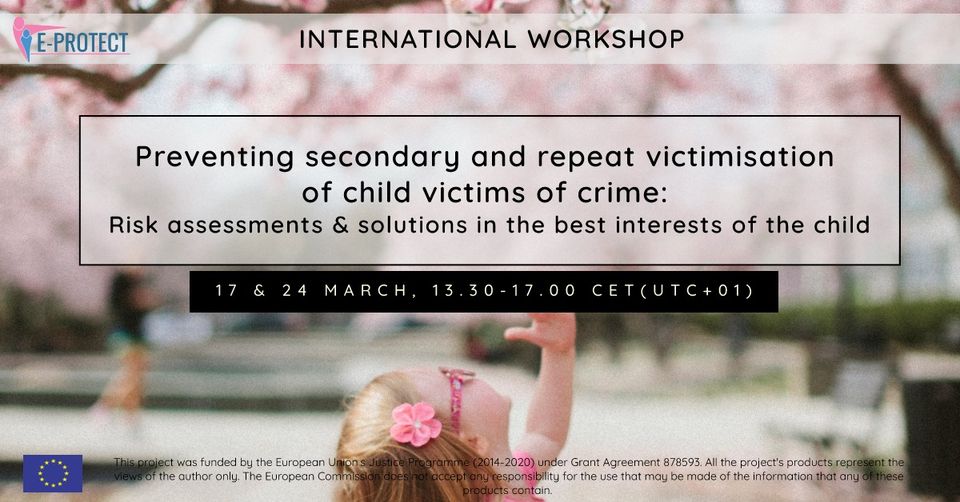Preventing secondary and repeat victimisation of child victims of crime:
Risk assessments and solutions in the best interests of the child
E-PROTECT II International Workshop – Agenda
17 and 24 March 2021
The event will be held in English and organised on a zoom platform with simultaneous translation in the languages of the project partners (Bulgarian, Greek, Italian, Romanian)
Times in CET
Registration is open at:
https://us02web.zoom.us/meeting/register/tZcuceCvrzkrHtz-ekwZa2lFA4mKpRiFpqU5
| First Day – 17 March 2021 | |
|
13.30
13.45 |
Joining the conference
Welcome and introduction to the webinar
|
| Panel 1: Safeguarding child victims of crime in the criminal justice system: The comprehensive approach of Barnahus for preventing secondary and repeat victimisation | |
|
13.55 |
Introduction to the panel by the Moderator |
|
14.00
14.30 |
The Barnahus model for child-sensitive justice: A comprehensive approach to prevent risks of secondary and repeat victimisation Introduction to the Nordic Barnahus model Bragi Guðbrandsson, Member of the United Nations Committee on the Rights of the Child, Founder of Barnahus and former Director of the Government Agency for Child Protection of Iceland
Challenges and solutions in setting up the “Childhood-Haus”: Experience and lessons learned from the implementation of the Barnahus concept in Germany Astrid Helling-Bakki, Executive Director, World Childhood Foundation Germany
|
|
14.50
|
Questions and discussion |
| 15.10 | Break |
| Panel 2: Preventing secondary and repeat victimisation of children in the criminal justice system: Experience from countries promoting solutions in the best interests of the child | |
| 15.25 |
Introduction to the panel by the Moderator
|
| 15.30 |
Preventing secondary and repeat victimisation of children, as well as intimidation and retaliation, in the criminal justice system Experience from the E-PROTECT partner countries Fotis Tegos, Social Worker-Juvenile Probation Officer, Office for the Protection of Child Victims "Spiti tou Paidiou" at Thessaloniki, Greek Ministry of Justice: The transitionprocess to the Office for the Protection of Child Victims "Spiti tou Paidiou" in Thessaloniki Juvenile Prosecutor Claudia de Luca, Italy: How risks of secondary and repeat victimisation, intimidation and retaliation create challenges for the prosecution of perpetrators of violence against children, Experience from Naples, Italy Judge Ivanichka Slavkova, District Court Varna, Bulgaria:Experience with the blue rooms in Bulgaria: Strengths and challenges Roberta di Bella, Lawyer, President of the Juvenile Chamber of Genoa, Member of the National Union of Juvenile Chambers, Italy: The role of lawyers to reduce risks of secondary and repeat victimisation, intimidation and retaliation of child victims of crime in the context of criminal investigations and proceedings: Introducing an initiative of the Juvenile Chamber in Liguria to train legal professionals and law enforcement services on these matters.
|
|
16.30
16.45 |
Discussion, questions and answers
Concluding remarks and closure of the meeting
|
Second Day – 24 March 2021 |
|
|
13.30
13.45 |
Joining the conference
Welcome and introduction to the webinar Recap from the first day
|
| Panel 1: International and European standards guiding the risk assessment of victims of violence: The work of GREVIO and the Committee on the Rights of the Child in monitoring implementation | |
|
14.00 |
Introduction to the panel by the Moderator Theoni Koufonikolakou, Deputy Ombudswoman for Children, Greece: The role of Ombudsoffices promoting the best interests of child victims of crime as independent authorities, The experience from Greece The work of GREVIO in promoting risk assessments in accordance with the Council of Europe Istanbul Convention Maria-Andriani Kostopoulou, Member of GREVIO Risks of child victims of intra-family and gender-based violence and solutions in the best interests of the child: Experience from the monitoring work of the Committee on the Rights of the Child Benoit Van Keirsbilck, Director of Defence for Children International – Belgium, Member of the Committee on the Rights of the Child National perspective on the implementation of international standards guiding risk assessments for child victims of violence: Isabella Mastropasqua, Director Office II, Juvenile and Community Justice Department, Italian Ministry of Justice: The role of the social services within the criminal justice system (in Italian)
|
| 15.15 |
Break
|
| 15.30 |
Introduction to the panel by the Moderator Risk assessment of child victims of violence: Approaches and methods Stella Karapa, Forensic Psychologist, Greece: Case example Taina Laajasalo, Chief Specialist and Forensic Psychologist, Finnish Institute of Health and Welfare: LASTA – A multi-professional risk assessment method from Finland Sabrina Reggers, Family Justice Centre in Limburg, Belgium: Multi-disciplinary risk assessments in the context of a Family Support Centre Comments and discussion
|
| 16.30 | Individual assessment of child victims of crime: Methodology E-PROTECT |
|
16.40
16.45 |
Concluding remarks Announcement of upcoming activities
Closure of meeting |
About E-PROTECT II:
E-PROTECT II fosters collaborative multi-stakeholder action in support of the full transposition and application of the EU Victims’ Rights Directive (2012/29/EU) in relation to child victims of crime. The main objective is to promote a child-centred and rights-based methodology for the individual assessment of child victims of crime, in accordance with articles 22-24 of the Directive.
From 2020 to 2022, the E-PROTECT partners are rolling out a series of events at national, bilateral and European levels to promote a child rights-based approach to the individual assessment of child victims of crime. In a partnership learning exercise, this series of webinars and meetings engage officials and professionals providing services for child victims of crime in law enforcement and the judiciary, social welfare and child protection, health care and education services and other relevant fields.
Information and contacts:
E-PROTECT website: http://childprotect.eu
Resources for download: The methodology for the individual assessment, European and national reports on the individual assessment and other resources, including translations in Bulgarian, German, Greek, Italian and Romanian. The E-PROTECT video introduces the individual assessment of child victims.
Visit the project website and follow us on Facebook, Twitter and LinkedInfor further information.
Join the E-PROTECT network of child protection professionals on the project’s virtual platform!
E-PROTECT II is implemented from 2020 to 2022 by the Law and Internet Foundation in Bulgaria; the South East European Research Centre in Greece; Defence for Children International – Italy in collaboration with the Department for Juvenile and Community Justice of the Ministry of Justice, Italy; and the Romanian Centre for European Policies.







